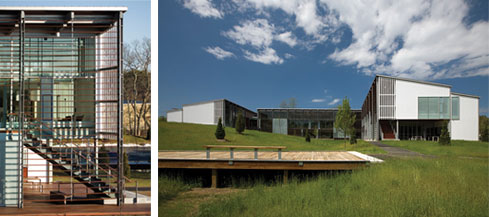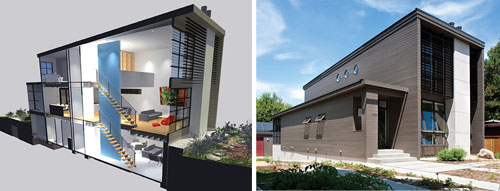Open BIM: Interdisciplinary Collaboration Strategies for a Plural World
For all of this information to be truly useful to the most people it must be readily accessible and available to each person and be able to address the different needs of each. NIBS points out that to the owner it means that "all of the collective information about how a facility was intended to perform, the incorporated pieces and parts, its operational requirements, its planned and actual performance, its occupants, etc. are securely available for use and analysis throughout the life of the facility." To project design and construction team members it means that "facility information and the basis for contractually exchanging it are transparently and consistently defined. It also means that required information can move quickly from one party to the next and from one application to another without requiring manual interpretation, re-keying, or risk of misinterpretation." To all participants in the facility life cycle it "provides the opportunity to use computer-based applications to view data in three-dimensional pictures, to view performance tables in easy-to-understand visual diagrams, to discover problems and conflicts while designs are still conceptual instead of waiting until they are discovered during physical construction, to predict a lifetime of utility consumption for each of several design and engineering options in order to select the most desirable one long before the facility details are specified and built, and a host of other highly desirable opportunities. In short, it provides the opportunity to design in ‘virtual' space before committing limited resources to the creation, care and feeding of a facility that will exist for perhaps fifty years or longer."
The ability for BIM to meet all of these various needs is not limited because of any lack of information. Generally the needed information is currently readily available. However, the rules and protocols for how to exchange and manage that information are not completely agreed upon yet, which is one of the reasons that the National BIM Standard is needed and welcomed.
IPD OverviewÂ
Integrated Project Delivery (IPD) has occasionally been misunderstood to simply mean that everyone on a design team works on the same BIM model. While that is one piece of the story, IPD is really much more than that. In 2007, the AIA IPD Guide stated that "IPD is a project delivery approach that integrates people, systems, business structures and practices into a process that collaboratively harnesses the talents and insights of all participants to optimize project results, increase value to the owner, reduce waste, and maximize efficiency through all phases of design, fabrication, and construction."Â In version 2 of the AIA/AIACC Integrated Project Delivery Guide, (anticipated in 2010) the updated working definition that is proposed is, "IPD is a project delivery method distinguished by a contractual agreement between a minimum of the owner, design professional, and builder where risk and reward are shared and stakeholder success is dependent on project success."
More than just sharing of information then, IPD is emerging as a completely different business and contractual model where the major stakeholders share the risks and rewards of a building or facility project, financial and otherwise. In fact, there are two versions of AIA Contract Documents that are now available for IPD projects. The "Transitional" contracts provide for collaboration between the architect, contractor, and owner in an arrangement modeled after existing construction manager agreements. These include:
- A295â„¢−2008 General Conditions of the Contract for Integrated Project Delivery
- B195â„¢−2008 Standard Form of Agreement Between Owner and Architect for Integrated Project Delivery
- A195â„¢−2008 Standard Form of Agreement Between Owner and Contractor for Integrated Project Delivery
- GMP (Guaranteed Maximum Price) Amendment to A195-2008
For those collaborations that are ready to fully integrate and skip past the Transitional phase, a Single Purpose Entity Agreement may be the way to go. AIA Document C195â„¢− "2008 Standard Form of Single Purpose Entity Agreement for Integrated Project Delivery" has been published for that purpose. This agreement allows for a complete sharing of risk and reward whereby, owners, architects, and constructors / builders agree to work together from the beginning under one master agreement to carry out the project with mutually agreed-upon goals and target costs. It typically also includes liability waivers among key participants to recognize, manage, and limit the risks of working together.
International Fund for Animal Welfare (IFAW) Headquarters |
 |
The new headquarters of the International Fund for Animal Welfare (IFAW) designed by DesignLAB architects is a COTE Top Ten Award winner. Photo: © Zane Williams |
This 54,000 square foot global headquarters building on Massachusetts's Cape Cod was designed by Boston-based DesignLAB architects. A worldwide organization devoted to protecting wildlife, the IFAW sought a sustainable building that maximizes the organization's global advocacy, strategic planning and communications. DesignLAB utilized a Building Information Model (BIM) to design a headquarters that facilitates open communication, collaboration and interaction. Using BIM and a collaborative process helped to accelerate the schedule of the project and ensure accuracy with early building estimates. The project manager, contractor and architect/engineering team formed an early partnership to fast-track the process and control cost. A 3D BIM process that integrated delivery system approvals, pricing, and early release packages enabled the team to condense what would have been a 37-month design and construction process into 26 months. The technology also helped the team raise the project's LEED rating. While the design initially aimed for LEED Certified or possibly Silver status, the project team continuously monitored project costs, procurement, and materials use throughout the construction process. As the project neared completion, the team realized it had achieved more LEED points than previously expected. When presenting this information to IFAW, they identified several areas where small additional expenditures or efforts would put the project over the Gold threshold. "We used BIM for the design of the IFAW headquarters in part because our structural engineer partner on the project already used BIM for all of its designs, and working with one BIM model facilitated work between our two firms," said architect Sam Batchelor of DesignLAB. "The ability for both architects and engineers to access the same product database and to collaborate on the 3D model saved time and money, a bonus for the client." The building was picked as one of the United States' top 10 best examples of sustainable architecture and green design by the AIA Committee on the Environment (COTE). The COTE Award is the AIA's top green award, honoring projects that demonstrate a thoroughly integrated approach to architecture, natural systems and technology. In addition to the COTE award, the IFAW headquarters received the AIA award for interior architecture and three additional awards from the Boston Society of Architects, including an honor award for design, an interior architecture award and a sustainability award. |
Â
The Ross Street House in Madison, Wisconsin |
 |
The Ross Street House in Madison, Wisconsin designed by Carol Richard of Richard Wittschiebe Hand (RWH) Architects achieved LEED for Homes Platinum level. Rendering: Richard Wittschiebe |
The Ross Street House in Madison, Wisconsin, was designed by (and is the new home of) Carol Richard of Atlanta-based Richard Wittschiebe Hand (RWH) Architects. The 2,700 square foot 3-level residence achieved 102 out of a possible 136 LEED certification points, and is one of only about 200 LEED Platinum homes nationwide. Richard's sustainable design features include large south facing windows with sunscreens, permeable paving, tankless water heaters, solar panels, a variety of recycled and regional materials, an energy efficient furnace, and rainwater collection system for irrigation. BIM played a particularly important role in helping Richards capture as much of the winter southern sun as possible while providing shade in summer. Using the BIM model, she created a controlled "light box" to determine sunlight patterns and design louvers that would allow the sun to penetrate the home between October and February, while shading the windows between May and August. Being a good neighbor was also an important design goal. The house sits on a small lot among a mix of postwar Cape Cod style homes and a few 1960's modern homes. The architect and her husband wanted to maintain the scale of the neighborhood and utilize its familiar materials. Richards used BIM to model the adjacent houses to see how well her design fit into the neighborhood. As a lover of modern design, she felt it equally important to create a space that reflected her own design sensibilities, and which would feel comfortable in scale. "With BIM we were able to design and view all elements of the project inside and out and share it with our integrated design team to spot and solve problems up front rather than discovering them when it was too late," said Richard. "When we decided to move to Madison, we were determined to create a new livable and efficient home for ourselves. We are interested in the environment and want to be good neighbors to the people who live on our street and to the world in which we live. Being able to model your design, site, environment and green strategies all within a single BIM model made attaining this goal much easier." |









